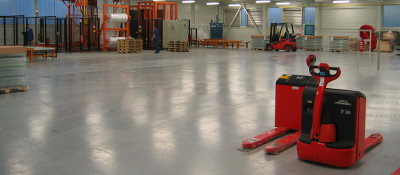ALIS GIK
GIK is the ALIS' Warehouse Management subsystem (WMS). Its job is to manage logistics operations, communicate with upstream software (such as the company's ERP system) and coordinate all of the other ALIS subsystems.
The subsystem supports all the operations required for transparent paperless warehouse management:

Electronic work orders for inbound and outbound material flow, picking, relocation and shipping of goods, transport unit formation (e.g. pallets, packages, containers) and other tasks.
Logistics operations planning, including special algorithms to optimize storage space and minimize time, labor, machinery and energy needs.
Work process management and coordination using workstation computers and mobile terminals (see the ALIS TIK module).
High-level coordination of operations performed by automated transportation segments (via the ALIS PIK module).
Operational and statistical reports generation.
Cost calculation.
E-document exchange with company's other information systems (via the ALIS KIK module).
Bar code printing (including pallet identification sheets) and RFID tag programming,
Document creation and printing (internal and official documents).
Availability and Management
ALIS GIK uses an advanced, in-house developed web-based user interface. Except for any reasonably modern web browser, there is no other client-side software required. This makes the system accessible from anywhere within the warehouse as well as from the company's intranet, the internet, various mobile devices, etc.
Workstations are mainly used for logistics operations management, such as generation, confirmation and activation of work orders, planning and control of transport routes, information access and document printing. Mobile terminals provide a more direct support to the work process, like handling, labeling and identification of goods, measurement and quality control, guidance and assistance to operators. Automated transport segments (carts, trucks, chain and roller conveyors, VNA elevators, etc.) can be controlled automatically by the ALIS PIK module, making operator interventions only necessary in cases of unavoidable congestion or hardware malfunction.
ALIS makes use of bar code and/or RFID as well as other automated identification systems. Mobile terminals connected through the ALIS TIK module provide an intuitive interface that was specially designed to assist with executing a broad set of different workflows.
Storage Services for Clients
ALIS can manage multiple warehouses in multiple locations for multiple users. It keeps records of stored goods' various characteristics (such as quantity, weight, volume, production date, etc.), together with storage duration and handling time. These are used for calculating the actual cost of storage and billing the users of warehousing services.
A separate user interface is available, allowing customers to access their status, events and costs information through the Internet.
Independent Operation
In its normal mode of operation ALIS GIK is always connected to company's other information systems. However, the system also supports a so called offline mode where it's capable of partialy or fully autonomous operations. A switch to this mode happens automatically whenever there are communication problems. Various emergency tools become available in the offline mode to help operators work around any affected functionality.
During emergencies, ALIS allows qualified warehouse staff to manually bypass certain restrictions enforced by the parent system, making sure the latter is properly informed of such situations. This allows continued operations in case of damaged goods, transport route interruptions or other events where intended operations are not feasible.

